There is no doubt that massive amounts of garbage are now hurting our dear environment. In fact, South Korea is reportedly the country with the second-highest plastic consumption per capita. According to a Euromap survey, the annual consumption of plastic packaging materials per person in 2020 was 67.4kg. It can be assumed that the amount of consumption has risen since the outbreak of COVID-19, as many people have their meals delivered to them.
To solve this global problem, a worldwide franchise coffee shop, Starbucks, is now using paper straws to reduce plastic waste. Moreover, a concept called “zero-waste” has emerged. It is a principle that encourages the reuse of all products to prevent any waste from them. Based on this principle, many people are joining the “zero-waste challenge” to help reduce waste in their daily lives and share tips to reuse products. To encourage this challenge, some shops are selling products that can be reused, such as shoes that are made from plastic waste.
However, it would be hard to reduce all of the waste in one’s daily life. The UOS Times conducted a survey to find out the opinions of University of Seoul (UOS) students on the concept of zero-waste and the zero-waste challenge.
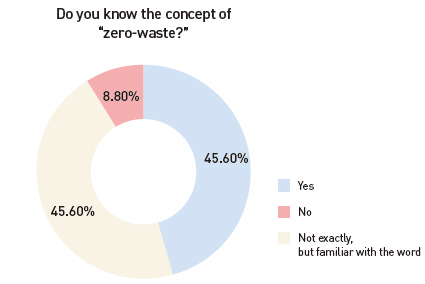
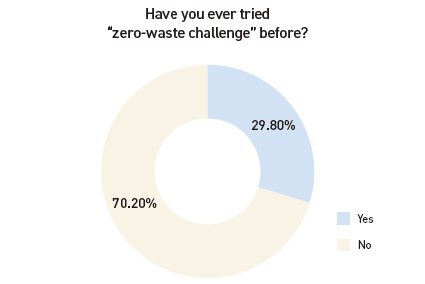
The majority of respondents (91.2 percent) are familiar with the concept of zero-waste, and half of them know the exact meaning of the concept. Moreover, about 30 percent of students have tried the challenge. This means that students of UOS are interested in reducing waste to protect the environment.


For the question “How long do you think a zero-waste challenge can last?” the majority of students (52.7 percent) answered “less than a week.” However, also the majority of students think positively of the challenge, in that they think it would be meaningful to reduce waste if many people join the challenge. With the result on base, the reporter decided to join the zero-waste challenge for a week as a college student living in Seoul, and share tips for our readers.
The following is a review of the one-week zero-waste challenge from the reporter’s point of view.
[Day 1]
On the first day of the challenge, it was essential to purchase zero-waste products. I visited one of the zero-waste shops “With Earth Store” (Jigurang gage) in Wolgye-dong, which is not very far from the UOS campus. Surprisingly, the shop not only sells zero-waste products but also collects used milk cartons and recycles them. Since milk cartons are different from other paper-made boxes, they are more likely to be recycled if they are thrown out separately. The clerk in the store also said that many people visit the store just to dispose of milk cartons. Moreover, there were paper bags to collect plastic waste by color to ensure that they are recycled properly.
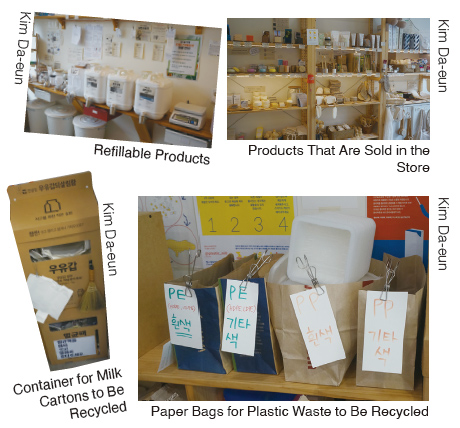
In the store, there were various zero-waste products. Refillable products, including detergents, dish soaps, baking soda, and sodium percarbonate were only sold in grams, which means that shoppers must bring their own cartons. Moreover, there were biodegradable loofahs and towels. On the first day of the challenge, this reporter bought biodegradable loofahs, dish towels, and a shampoo bar that was not packed in a plastic container.
[Day 3]
To show readers the variety of zero-waste products, I visited the “LAR” offline shop, a waste-reduced fashion brand. This shop is located in a so-called “hot place,” Seongsu-dong. According to the brand’s website, the shop focuses on “responsibility of fashion,” which involves reducing waste from fashion items and making products from eco-friendly fabrics in sustainable design.
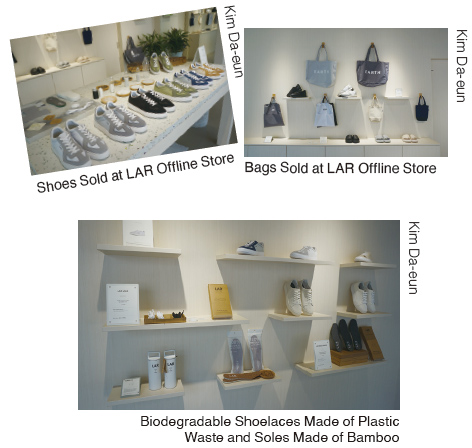
The most distinctive feature of the store was that the signs show visitors the materials that were used in each product. For instance, there are shoelaces made from used plastic and insoles made from peels of cork trees and rubber trees, which are biodegradable. The outsoles of the brand’s shoes are the most impressive, as they are made out of the brand’s original material invented in cooperation with Symphony, an England-based company. The material is highly biodegradable as it mostly consists of natural Guatemalan rubber trees.
[Day 5]
On the fifth day of the challenge, living waste-free felt harder than I thought. It was difficult to hang out with friends in a café or to have food delivered in plastic containers. Therefore, I went to a “less-waste” café, “PSB Coffee Bar.” This café is operated under “less-waste” and “plastic-free” principles. All of the disposables used in the café are biodegradable, and customers can get a 1,000 KRW discount if they bring reusable cups. Moreover, with proper containers, coffee beans can be sold in grams. There were various menus, such as vegan or decaffeinated drinks, cookies, and cakes.
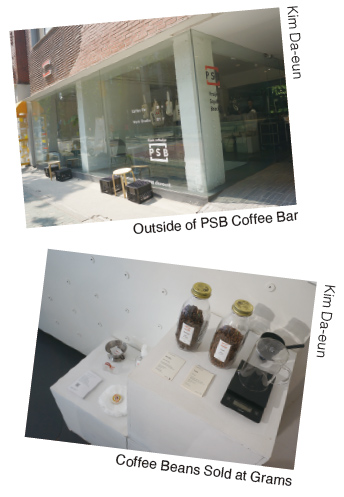
The interior design was also unique. The first floor is a normal café, but the first basement level offers tables that customers can use with their laptops and tablets. I thought that for college students who want to do their assignments or study for their exams with a fine cup of coffee, this space would suit their needs.
[Day 7]
On the last day of the challenge, I decided to celebrate the successful end of the challenge in a zero-waste way. There is a zero-waste bar in Cheongdam-dong, another so-called “hot place.” One of the bartenders explained the meaning of the bar’s name, “Zest,” which stands for both peels of citrus fruits and a short term for zero-waste. He also mentioned their efforts to reduce waste. They serve craft gin and make sodas themselves to reduce bottle waste. Furthermore, these efforts can be seen in many other ways, such as fabric towels instead of paper towels, biodegradable toilet tissues in restrooms, and reusable wet wipes.

The bartender said that although the handwashing soap in the restroom is in a plastic container, it could be refilled so that the container can be used repeatedly. Their principle of reducing waste is also applied to food waste. For instance, the pulps from juiced carrots are reused as pickles and garnishes for other drinks. This bar is highly recommendable for its delightful drinks and delicious free snack chips.
Reporter’s Review
Surely, the zero-waste challenge is not called a “challenge” for nothing. The hardest part was not using disposables, which bring convenience to many people’s lives. Always carrying reusable cups was not hard because those are handy and many cafés in Korea offer discounts for reusable cups. However, not using disposables such as plastic containers from delivery food was quite hard. Almost every meal had to be homemade, which is not easy because most groceries use vinyl packaging.

Although the challenge was not easy, the bright side was overwhelming. First, the consequences are directly noticeable. Trash bins were filled up much more slowly, and it took much less time to throw away disposables. Moreover, as I spent less money on the food delivery service, I was able to buy zero-waste products, such as a pair of LAR sneakers.
After the challenge, the feeling of doing something worthy of saving the Earth made me very proud. This challenge was not easy, but worthwhile. Moreover, I am willing to challenge myself in the future for longer than a week. The UOS Times also highly encourages dear readers to join the zero-waste challenge; not only is it a way to protect the environment but it is also rewarding.
Reduce waste, save the Earth!

Kim Da-eun
daeunkim749@uos.ac.kr

